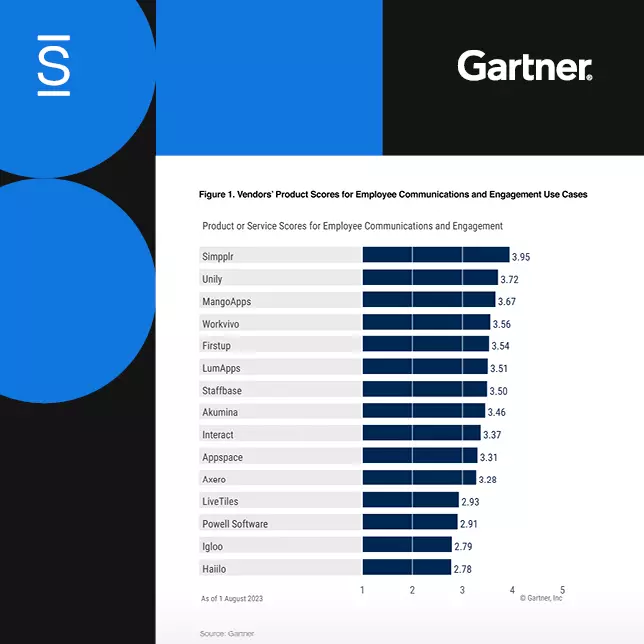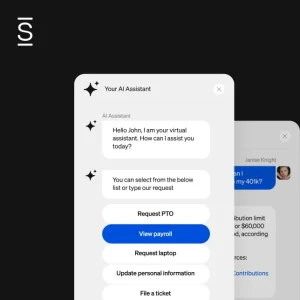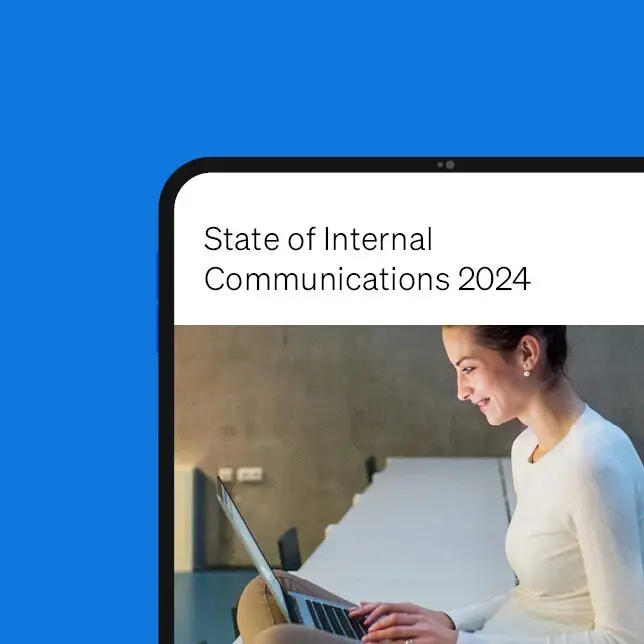Level up your internal communications game with actionable findings from Simpplr’s 2024 State of Internal Communications Report. Get practical tips and best practices — from how to position IC as a strategic advantage to secure more budget to using artificial intelligence to do more with less.
In a recent webinar, Blueprints for Success: Actionable Findings from Simpplr’s 2024 State of Internal Communications Report, Chief Insights Officer Jordan Katz and Senior Manager of Internal Communications Christine Robertson shared data-based insights to drive more effective employee communications.
Scroll down for highlights and watch the webinar for the full story.
Relationship between workplace setting and budget allocation
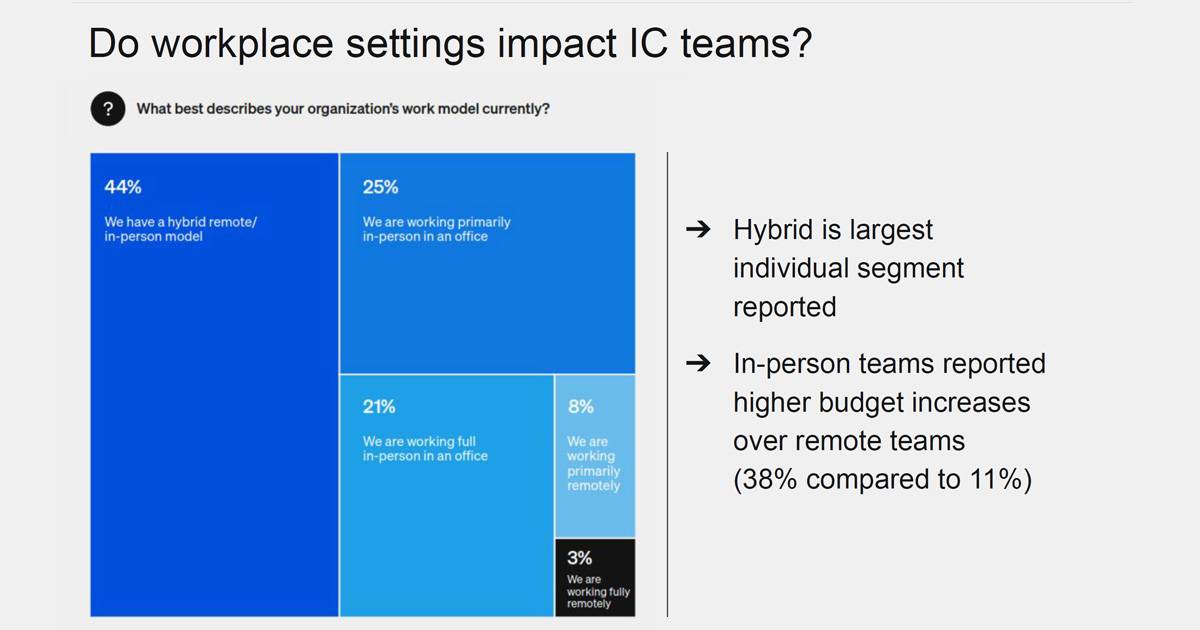
The IC landscape is in constant flux, with remote, hybrid and in-office work models now firmly entrenched. However, the State of Internal Communications research uncovered a distinct disparity: in-person teams hold a significant advantage in securing larger budget increases — (38%) compared to remote teams (11%).
Jordan said this is likely rooted in the increased opportunities for cross-functional collaboration and greater visibility afforded by a shared physical workspace. “When you enlist others, when you gather input from others, when you create fully bought-in leaders — which oftentimes takes being in the office and having greater contact cross-functionally, which doesn’t typically happen when you’re just in a remote Zoom meeting or Google meeting environment — there tends to be a larger impact, or at least the perception of larger impact, which results in an easier path to getting your budget approved.”
Christine agrees that building a strong internal network of comms advocates drives success.
“That’s my superpower. I personally build a champion network on both the executive level and on the user level. I will gather people who are particularly highly engaged within the company who can help me build a communication roadmap together because I want to be able to understand what’s happening at the high level, but I also want to understand what’s happening on the ground floor. It’s really, really valuable to have both of those networks established, especially as you move quickly throughout.”
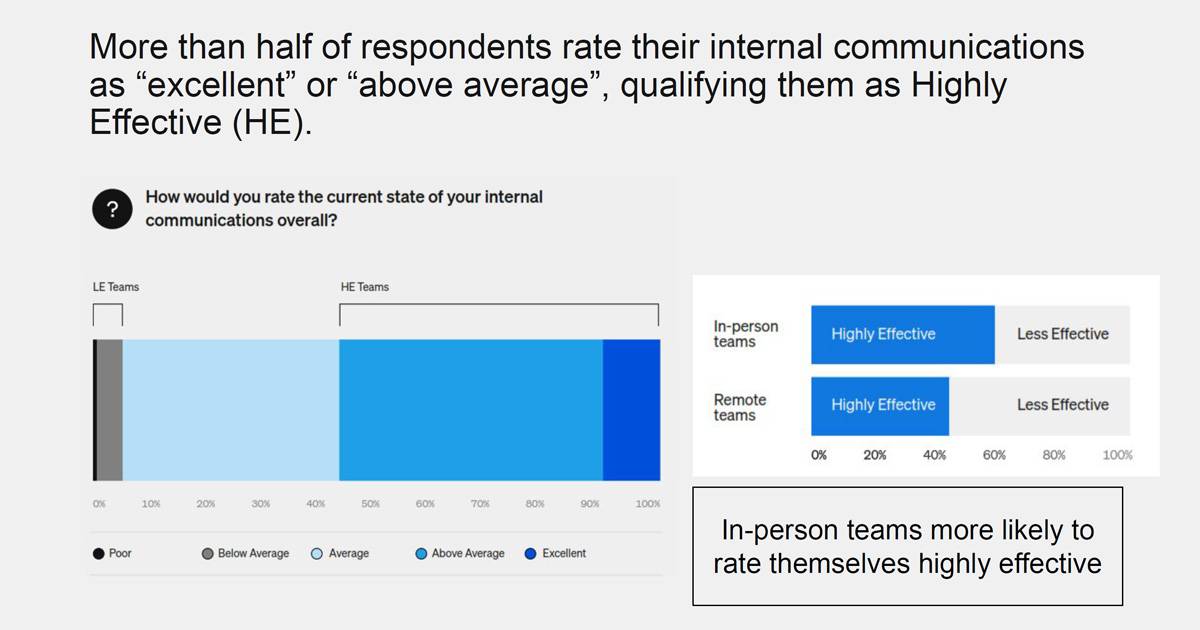
Actions for IC teams
- Remote and hybrid teams should look for more opportunities to collaborate across the organization and demonstrate value to budget-holders.
- Build your internal champions — focus on people managers. Meet quarterly to build your communication roadmap.
- Measure the effectiveness of your communications (more on this below) and share the results to make your case for continued and increased investment in internal comms.
Get a free template to start building a business case for better IC tech
Using AI as an accelerator
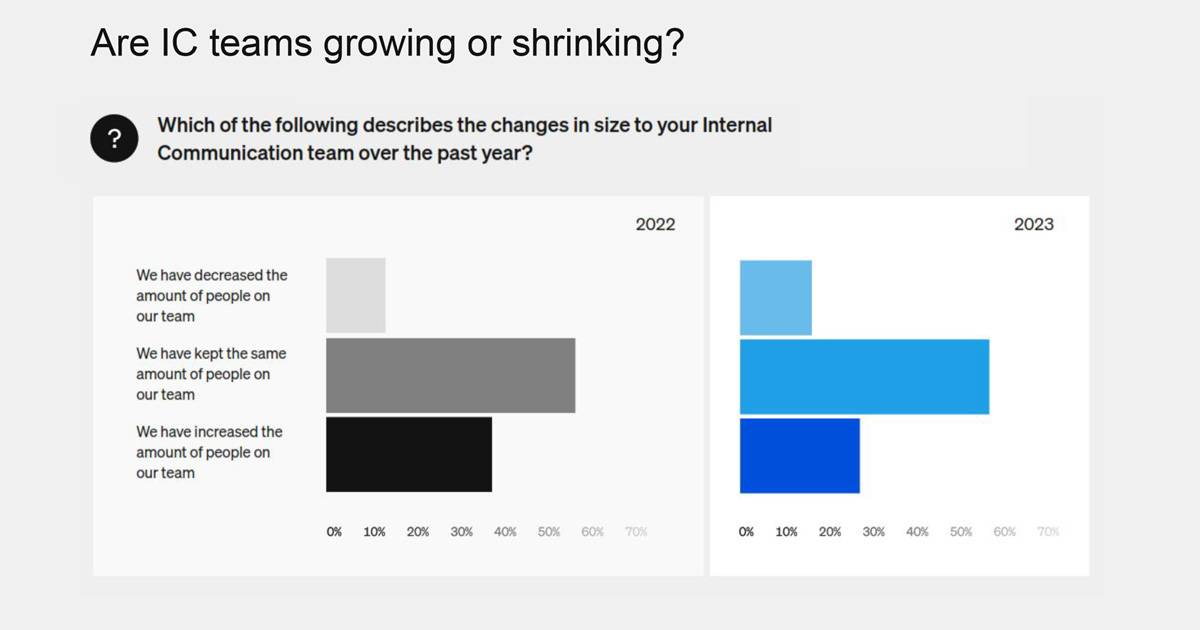
The research indicates that IC teams that strategically use AI and other new technologies are seeing boosts in productivity and internal comms effectiveness despite flat or decreasing headcount.
The data shows that the number of respondents indicating that their team plans to grow this year has not changed, yet significantly more employees report feeling adequately staffed to meet organizational needs (up from 50% in 2022 to 60% in 2023). And one-quarter of teams that anticipate a cut in staffing indicate the decrease is a direct result of additional AI support/functionality as opposed to budget cuts.
“For those companies that are decreasing headcount, those that were able to do much more with less tended to have an increased reliance on AI support or functionality to mitigate the negative impact of losing headcount,” Jordan said. “People are using AI as an accelerator to fight against inertia.”
AI doesn’t replace human creativity; it accelerates processes and boosts efficiency.
AI tools like ChatGPT can jumpstart internal comms strategy and content creation work to save time. Among other performance drivers for IC teams, AI-powered employee experience platforms can guide personalization and audience targeting for increased comms effectiveness. This empowers internal communicators to dedicate more time to high-level strategy and crafting impactful messages.
“AI is not about replacing our creativity. It’s about removing the roadblocks — the repetitive tasks that take up valuable time,” Christine says. “AI lets us focus on what truly matters: crafting strategic communications that resonate.”
Explore how to use AI to personalize and target internal comms
Actions for IC teams
- Do a tool audit. Do you have the right tools to help you scale?
- Lean into AI. If you’re not already using AI tools for internal comms, raise your hand to be a first adopter. Leadership can use the rollout of AI and other new technologies within IC teams as a blueprint for other departments to leverage innovative tech solutions to increase productivity, operational efficiencies and overall organizational performance.
- Use audience-based AI prompts to create custom communications by audience.
Check out this cheatsheet for optimized AI prompts to streamline common IC workflows
Define goals and measure success
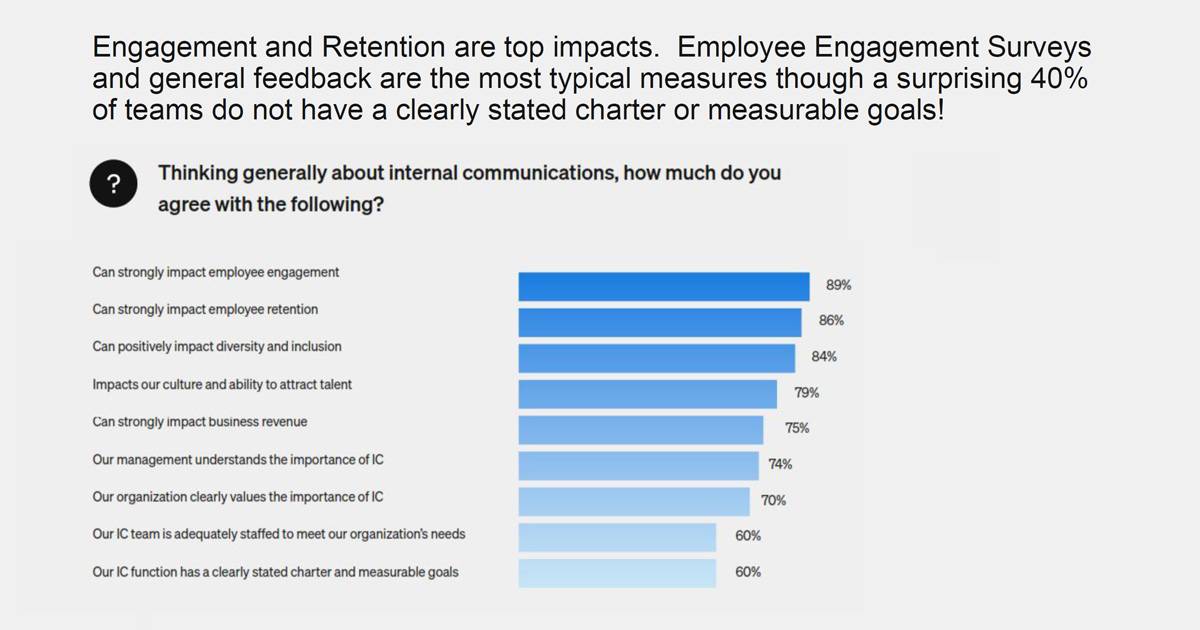
Internal communications plays a vital role in driving employee engagement, retention, diversity and inclusion efforts, and overall organizational success. Yet, as Jordan highlights, a concerning 40% of IC teams lack clearly defined goals and measurable metrics. This gap hinders them from fully demonstrating their value and impact on the organization.
“The most important thing that we can do as communicators is establish our charter so we can help guide and strategize with our internal stakeholders,” Christine said. “What’s our purpose? What are our goals? What does success look like?”
Focusing on measurement has cascading benefits, leading to increased collaboration with executive leaders, improved budgets, better tools, and an overall higher likelihood of success.
“Charter aside, not having any sort of measurable goals suggests that while they believe that, yes, IC can strongly impact employee engagement and retention, inclusion and revenue and all that stuff, we’re not actually going to put our money where our mouth is and measure that,” Jordan said.
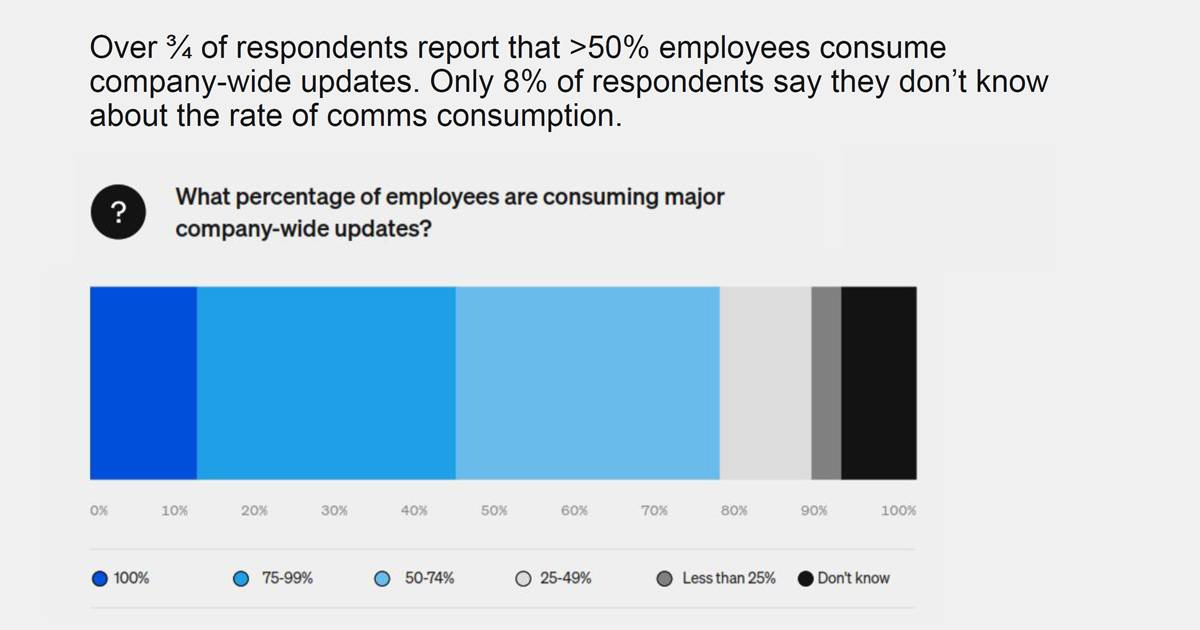
The vast majority of internal communicators who responded to the State of Internal Communications survey have the potential to access and analyze fundamental readership data, with only 8% stating they lack the tools or systems to track message viewership.
But this readership metric shouldn’t be the end goal for your IC efforts.
Think of it as the foundation — ensuring your messages can be widely seen. From there, consider more nuanced ways to measure the impact and action spurred by your communications.
Highly effective (HE) IC teams stand out in these key areas:
- Clear charter and goals: 76% of HE teams have a clear charter outlining their purpose and well-defined, measurable objectives guiding their work.
- Communicating value: HE teams actively communicate the value of their IC initiatives to management and the broader organization.
- Adequate staffing: HE teams tend to be more adequately staffed or utilize tools and collaborations to increase efficiency and impact.
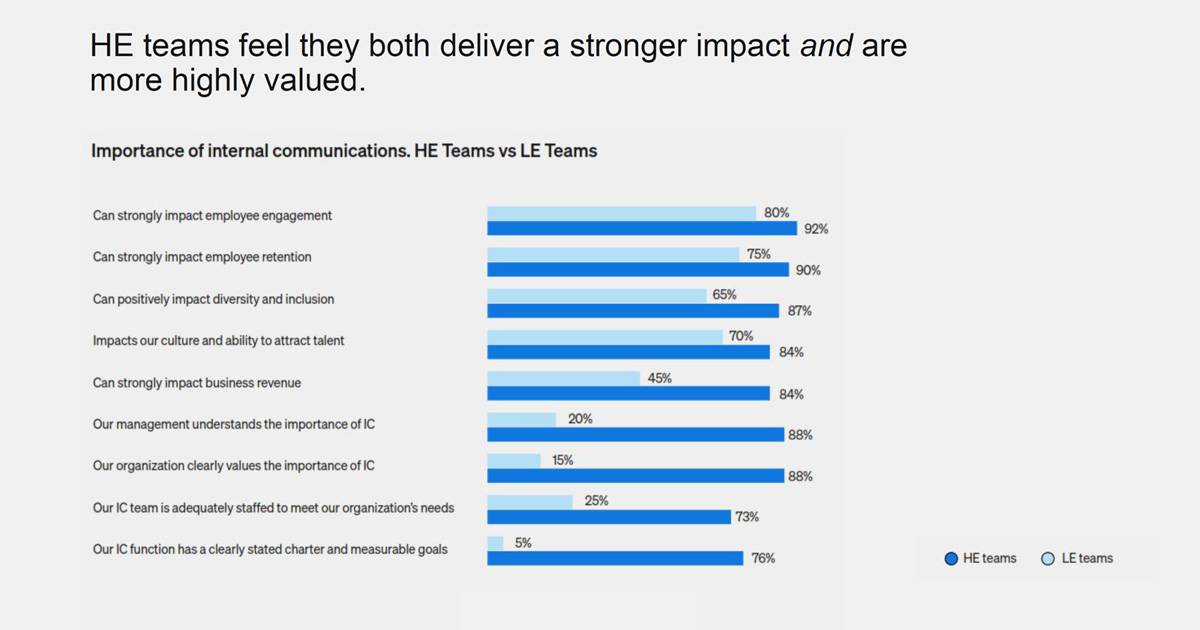
Actions for IC teams
- Establish goals and create (or refine) your team charter. Ask:
- What are the outcomes we want to influence?
- How will we measure our impact on those outcomes?
- How do we prove our efforts are moving the needle on those key metrics?
- Use data from tools to make better decisions on content and channel distribution.
- Consistently measure. Track employee sentiment for all-company communications.
Tip: Use basic knowledge consumption metrics (% of employees consuming content) as a starting point. Tracking what percentage of employees consume company-wide updates provides a baseline of how well key messages are penetrating the workforce. While 100% readership might not be realistic, aiming for a 75-99% ingestion rate is a strong indicator that IC efforts are reaching and informing employees.
Learn how to measure the ROI of internal communications
More actionable insights to boost comms effectiveness
Jordan and Christine shared many more tips and best practices to improve the effectiveness of internal communications based on the research findings. Here are few standouts:
- Get executive alignment. “Getting clear direction from leadership about organizational priorities is essential for authenticity and focus in our communication,” Christine said.
- Map internal communications to business goals. Align IC efforts to overall organizational objectives and use data to show how comms directly supports those business goals. This creates a compelling case for the strategic value of internal communications.
- Measure sentiment. Use employee surveys and other feedback mechanisms to better understand how communications land and iterate for improvement.
Want to learn more? Watch the full webinar for a wealth of actionable findings from the 2024 State of Internal Communications report.

